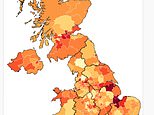In fact, smoking rates have increased in 20 districts across the UK in the last decade, despite a huge government effort to stamp out the killer habit.
Official statistics suggest that the proportion of adults addicted to cigarettes has even doubled in some parts of the country since 2012.
This comes even though smoking rates across Britain have fallen to a record low.
According to the Office for National Statistics, only 11.9 per cent of adults lit up cigarettes regularly in 2023. This equates to around 6 million people.
Smoking is now especially unpalatable among Generation Z, as rates have dropped by 60 percent among 18- to 24-year-olds since modern records began.
Despite the crisis, which has been accompanied by a meteoric rise in vaping, figures suggest smoking rates have risen by 134 per cent in Uttlesford, Essex.
About 24.9 percent of Uttlesford residents smoked in 2023, compared to 10.6 percent in 2012.
South Holland, in Lincolnshire, saw the second biggest increase (77.7 per cent), according to MailOnline analysis, rising from 14.8 per cent to 26.3 per cent.
The two areas recorded the highest rates in the UK.
Although 20 districts have defied national trends, 17 authorities are now technically “smoke-free”.
The Government defines this situation as less than 5 percent of the adult population being current smokers.
Ministers are aiming to make England smoke-free by 2030, with a possible ban on lighting up in pub gardens, near football pitches and even outside nightclubs looming.
Areas that have already met the threshold last year include St Albans, Hertfordshire and Woking.
Due to small sample sizes in local areas, figures for an individual year may vary more than expected from previous years.
Men are more likely to smoke than women, regardless of other factors.
Young people aged 18 to 24 have seen the steepest drop in smoking rates since 2011, falling from more than 25 percent to less than 10 percent in 2023.
Currently, the legal age to purchase cigarettes in the UK is 18 years old.
Under plans currently in the pipeline, ministers want to raise the sales age by one year each year from 2027. This would mean those born after January 1, 2009 would never be able to legally buy cigarettes.
Separate figures from the ONS also revealed that the prevalence of vaping has risen from around 4 per cent to almost 10 per cent.
Vaping was highest among people aged 16 to 24, with more than one in six using devices that come in a variety of flavors and colorful packaging.
The NHS considers vaporisers, or e-cigarettes, to be a useful aid in stopping people from using more harmful traditional tobacco products.
But experts have expressed concern about a significant increase in the number of people who have never smoked and use them because they still produce addictive nicotine. E-cigarettes also contain harmful toxins and their long-term effects remain a mystery.
Research yesterday suggested that around 1 million people in England who have never had a traditional cigarette are vaping.
In addition to its plans to eradicate smoking, the previous Conservative government had also promised to ban disposable e-cigarettes and curb the growing epidemic of child vaping.
According to Trading Standards, children as young as eight have picked up the habit.
They are sold in flavors such as strawberry ice cream, cotton candy and cherry cola, while some brands also feature cartoon characters.


